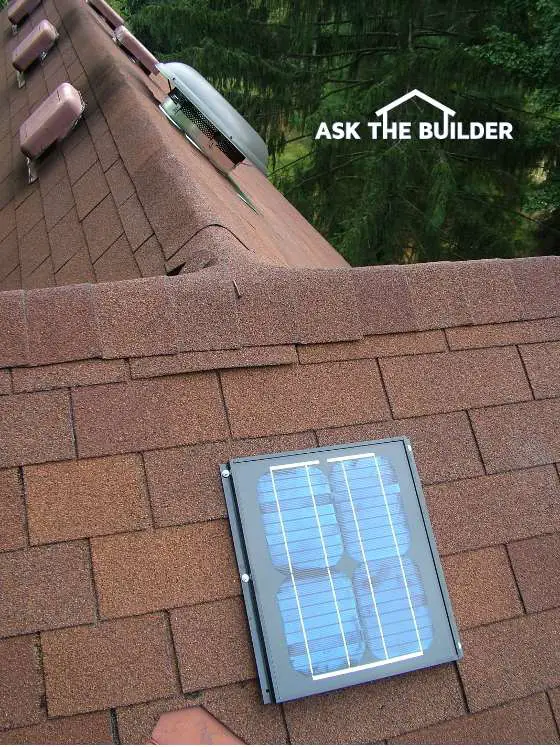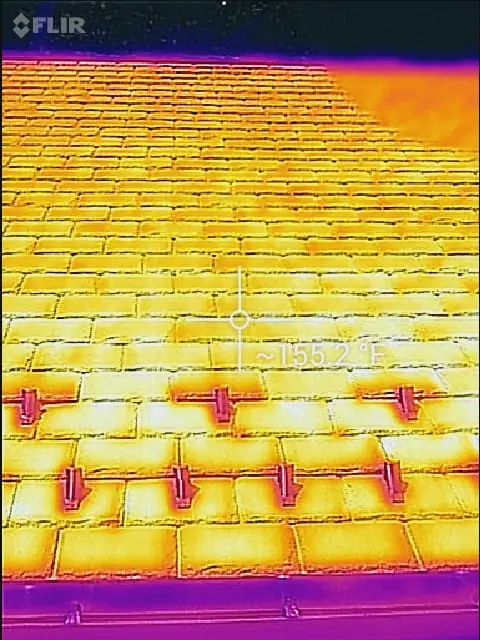Solar Powered Attic Fan

This solar panel produces enough electricity to power a spinning fan in the round ventilator on the roof at the top of the photo. See it? But the fan only works when the panel is basking in sunlight. The fan does not lower the temperature in the attic at all. I feel solar fans are a waste of money. Copyright 2018 Tim Carter
"But after seeing my solar-powered attic fan work, I have a long list of cons."
Solar Powered Attic Fan Checklist
- fans don't move lots of air
- fans slow down or stop when most needed
- there may never be an ROI!
In Tim's July 7, 2019 Newsletter, he ponders on why solar-powered attic fans are, for the most part, hype and a classic case of an emotional fuzzy-feel home improvement purchase in all too many cases.
DEAR TIM: My attic space gets as hot as blue blazes. I saw an advertisement for a solar-powered attic fan and that seems like a great way to remove heat and reduce my carbon footprint.
Do these fans really work, and are they hard to install? Will the fan significantly reduce the temperature inside my attic? What are the pros and cons to these solar attic fans? Brad L., Phoenix, AZ
Related Links
Turbine Vents Best Vents of All
Cool Your Attic FAST - DO NOT SHARE - Secret Info Here
DEAR BRAD: I installed a solar-powered attic fan last year to see how well it would work. The installation went like clockwork.
When is The Best Time to Install the Fan?
I had decided to do the work early in the morning while it was cool on the roof. Within an hour after installing it, the sun hit the solar panel and the fan blades started to spin. It was almost magical to see the solar attic fan work.
You're a pretty clever guy to get the sun to do double duty. It makes perfect sense to make the sun cool your attic space, since it is the source of the problem in the first place.
Free & Fast Bids
CLICK HERE to get FREE & FAST BIDS from local attic fan installers.
Are Solar Attic Fans Really Earth-Friendly?
As for reducing your carbon footprint by not using electricity from a power plant, I can't tell you if the solar fan you might buy will be that environmentally friendly. The manufacturing process used to make your solar fan might actually be quite carbon positive. But in any event, you might be doing the right thing by trying to use a solar-powered fan.
Are There Pros and Cons to Solar Powered Attic Fans?
There are pros and cons to solar-powered attic fans. Here's a list:
- they work for free using the suns rays
- they do exhaust some hot air
- the solar fans do not require the services of an electrician to connect
- they are also very quiet
What are the Cons?
But after seeing my solar-powered attic fan work, I have a long list of cons:
- My fan only works when it is getting direct sunlight on the solar panel
- If a cloud drifts through the sky blocking out the sun, the fan stops spinning immediately
- As the sun sets, the attic is still hot and my solar fan stops spinning
- The fan I have moves only 800 cubic feet of air per minute (CFM) when the sun is shining directly on the solar panel
Does the Fan Spin at Different Speeds?
Yes, the solar powered attic fans spin at different speeds.
If the angle of the sun is lower in the sky (morning and late afternoon) or the sun's rays are trying to cut through thin clouds or haze, the fan spins slower moving less air.
The single solar-powered attic fan I have has not lowered the temperature in my attic at all. I took precise before and after temperature readings.
How Much Air Must Move Through the Fan To Cool an Attic?
To significantly reduce the temperature in your attic, you need thousands and thousands of cubic feet per minute (CFM) of air moving through the attic space.

This is an infrared photo of my own roof. See the white crosshairs and temperature reading? 155F That's blazing hot and it's possible it can go as high as 170 F. The entire inside of the attic can reach this temperature. Copyright 2018 Tim Carter
What's more, this air needs to continue to move through the attic space after the sun sets to remove the residual heat from the roof framing lumber, roof sheathing, roofing materials, and the attic insulation. Yes, the insulation in your attic gets very hot during the day and then holds that heat long after the sun sets.
Chicken growers know all about this. Chicken farms in any area of the world that gets hot MUST HAVE enormous fans moving tens, perhaps hundreds, of thousands of CFM of air through the growing houses to keep the chickens alive in hot weather.
It's all about moving vast amounts of air in your attic if you want to lower the temperature inside your attic space. Period. Solar-powered fans don't do this.
CLICK HERE to get FREE & FAST BIDS from local attic fan installers.
How Hot is it in an Attic?
Attic temperatures in the summer on a hot day can easily get to 140 F. In late June early July with the sun passing through the least amount of atmosphere in the Northern Hemisphere, an attic could get up to 160 F, or more.
How Many Solar Fans Do I Need to Cool my Attic?
If you are going to go solar, I urge you to by several solar-powered attic fans. You will need them. You may need fifteen or more to move thousands of CFM of air through your attic.
Where Should the Solar Panel be Located?
The solar panel should be located away from the actual fan. In the Northern Hemisphere, you want the solar fan pointing due south.
My solar fan has this neat feature. This allowed me to put my solar fan on the rear portion of my roof so you don't see it from the street, while the solar panel is on the part of my roof that faces due south.
Should the Fans be in Direct Sunlight?
You want the solar panels located on the roof where they will not be shaded by trees, and where they will get direct solar power from Noon until sunset. This is the hottest part of the day, that part where you need the fan blades spinning at full speed.
Do I Have to Cut a Hole in My Roof?
Solar-powered attic fans require a hole to be cut in the roof, possibly two if you purchase one that has the remote-panel location feature. If you do not know how to properly flash these fan housings into the roof shingles, then you should hire a qualified roofer.
It's not hard to do the work, but there are very important steps that must be followed to have a leak-proof installation.
Do These Fans Require Caulk?
When installed properly on a roof with standard asphalt shingles, solar-powered attic fans do not require caulk, roofing cement or any other product to prevent leaks. A great roofer will cut the shingles and lace the fan housing into the shingles so that rain will stay outdoors where it belongs.
How Much Air at a Minimum Needs to Move Through My Attic?
If your attic space is over 1,800 square feet, you will need enough solar fans to move 8,000 CFM. You need that amount of air, if not more, to get any sort of cooling benefit from the fans.
Intense sunlight can create heat faster than one or two small fans can cool an area. If you want to see how to properly cool attic spaces, visit a chicken farm. These farmers use giant fans that move tens of thousands of CFM of air that keep the chickens alive.
CLICK HERE to get FREE & FAST BIDS from local attic fan installers.
Column 676


27 Responses to Solar Powered Attic Fan